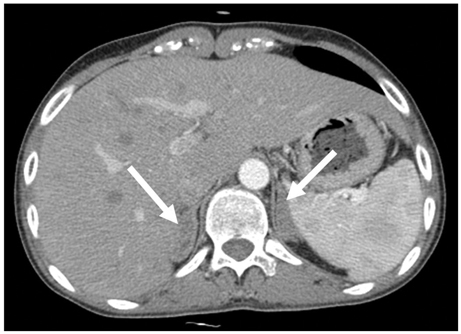Yonsei Med J.
2012 May;53(3):658-661. 10.3349/ymj.2012.53.3.658.
Male Pseudohermaphroditism Presented with Sudden Cardiac Arrest
- Affiliations
-
- 1Division of Cardiology, Severance Cardiovascular Hospital, Yonsei University College of Medicine, Seoul, Korea. cby6908@yuhs.ac
- KMID: 1777005
- DOI: http://doi.org/10.3349/ymj.2012.53.3.658
Abstract
- Torsades de Pointes is a life-threatening arrhythmia associated with a number of causes, but is very rare among endocrinologic disorders. We report a case of male pseudohermaphroditism with hyperaldosteronism due to a 17alpha-hydroxylase deficiency presented with sudden cardiac arrest.
MeSH Terms
Figure
Reference
-
1. Yanase T, Simpson ER, Waterman MR. 17 alpha-hydroxylase/17,20-lyase deficiency: from clinical investigation to molecular definition. Endocr Rev. 1991. 12:91–108.
Article2. Peter M, Sippell WG, Wernze H. Diagnosis and treatment of 17-hydroxylase deficiency. J Steroid Biochem Mol Biol. 1993. 45:107–116.
Article3. Matsumura K, Fujii K, Kansui Y, Arima H, Iida M. Prolongation of the QT interval in primary aldosteronism. Clin Exp Pharmacol Physiol. 2005. 32:66–69.
Article4. Maule S, Mulatero P, Milan A, Leotta G, Caserta M, Bertello C, et al. QT interval in patients with primary aldosteronism and low-renin essential hypertension. J Hypertens. 2006. 24:2459–2464.
Article5. McGowan GK, Walters G. Ventricular arrhythmias and hypokalemia. Lancet. 1976. 2:964.6. Kozhevnikov DO, Yamamoto K, Robotis D, Restivo M, El-Sherif N. Electrophysiological mechanism of enhanced susceptibility of hypertrophied heart to acquired torsade de pointes arrhythmias: tridimensional mapping of activation and recovery patterns. Circulation. 2002. 105:1128–1134.
Article7. Letsas KP, Efremidis M, Kounas SP, Pappas LK, Gavrielatos G, Alexanian IP, et al. Clinical characteristics of patients with drug-induced QT interval prolongation and torsade de pointes: identification of risk factors. Clin Res Cardiol. 2009. 98:208–212.
Article8. Lee SY, Kim JB, Im E, Yang WI, Joung B, Lee MH, et al. A case of catecholaminergic polymorphic ventricular tachycardia. Yonsei Med J. 2009. 50:448–451.
Article9. Gotyo N, Kida M, Horiuchi T, Hirata Y. Torsade de pointes associated with recurrent ampulla cardiomyopathy in a patient with idiopathic ACTH deficiency. Endocr J. 2009. 56:807–815.
Article10. Aydin A, Okmen E, Erdinler I, Sanli A, Cam N. Adrenal adenoma presenting with ventricular fibrillation. Tex Heart Inst J. 2005. 32:85–87.
- Full Text Links
- Actions
-
Cited
- CITED
-
- Close
- Share
- Similar articles
-
- Medullary Infarction Presenting as Sudden Cardiac Arrest: Report of Two Cases and Review of the Literature
- Cardiac Arrest during Tracheostomy Cannula Misplacement - A Case of Diphtheria
- A Sudden Cardiac Arrest during Spinal Anesthesia
- A Sudden Unexpected Death in Epilepsy
- Cardiac Arrest under Anesthesia in a Child with Previously Undiagnosed Long QT Syndrome: A case report




